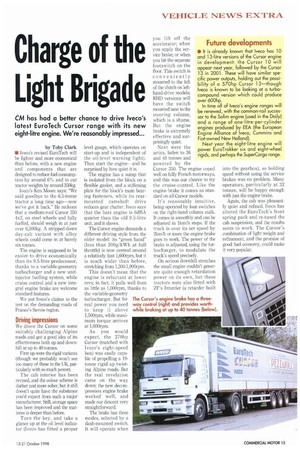Charge of the Light Brigade
Page 17

If you've noticed an error in this article please click here to report it so we can fix it.
CM has had a better chance to drive iveco's latest EuroTech Cursor range with its new eight-litre engine. We're reasonably impressed...
by Toby Clark • Iveco's revised EuroTech will be lighter and more economical than before, with a new engine and components that are designed to reduce fuel consumption by around 6% and to cut tractor weights by around 350kg.
Iveco's Ken Moore says: "We said goodbye to the 6.5-tonne tractor a long time ago—now we've got it back." He reckons that a medium-roof Cursor 350 4x2, on steel wheels and fully fuelled, should weigh in at just over 6,500kg. A stripped-down day-cab variant with alloy wheels could come in at barely six tonnes.
The engine is supposed to be easier to drive economically than its 9.5-litre predecessor, thanks to a variable-geometry turbocharger and a new unitinjector fuelling system, while cruise control and a new integral engine brake are welcome standard features.
We put Iveco's claims to the test on the demanding roads of France's Savoie region.
Driving impressions
We drove the Cursor on some suitably challenging Alpine roads and got a good idea of its effectiveness both up and downhill at up to 40 tonnes.
First up were the rigid variants (though we probably won't see too many of these in the UK, particularly with so much power).
The cab interior has been revised, and the colour scheme is darker and more sober, but it still doesn't quite have the substance you'd expect from such a major manufacturer. Still, storage space has been improved and the mattress is deeper than before.
Turn the key, and take a glance up at the oil level indicator (Iveco has fitted a proper level gauge, which operates on start-up and is independent of the oil-level warning light). Then start the engine—and be surprised by how quiet it is.
The engine has a sump that is isolated from the block on a flexible gasket, and a stiffening plate for the block's main bearing fasteners, while its rearmounted camshaft drive reduces gear chatter. Twee says that the bare engine is 6d13A quieter than the old 9.5-litre unit, and it shows.
The Cursor engine demands a different driving style from the older model: its "green band" (less than 200g/kWh at full throttle) is now centred around a relatively fast 1,600rprn, but it is much wider than before, stretching from 1,300-1,900rpin.
As you would expect, the 270hp Cursor (matched with Iveco's eight-speed box) was easily capable of propelling a 19tonne rigid up twisting Alpine roads. But the real revelation came on the way down: the new decompression engine brake worked well, and made our descent very straightforward.
The brake has three modes, selected by a dash-mounted switch. It will operate when you lift off the accelerator; when you apply the service brake; or when you hit the separate footswitch on the floor. This switch is conveniently mounted to the left of the clutch on lefthand-drive models; RHD versions will have the switch mounted next to the steering column, which is a shame. But the engine brake is extremely effective arid surprisingly quiet.
Next were the artics, laden to 36 and 40 tonnes and powered by the Cursor 350. The engine coped well on hilly French motorways, and this was our chance to try the cruise-control. Like the engine brake it comes as standard on all Cursor models.
It's reasonably intuitive, being operated by four switches on the right-hand column stalk. It comes in smoothly and can be adjusted in lkm/h steps. If the truck is over its set speed by 2km/h or more the engine brake goes to work. The power of the brake is adjusted, using the turbocharger, to modulate the truck's speed precisely.
On serious downhill stretches the small engine couldn't generate quite enough retardation power on its own, but these tractors were also fitted with ZF's Intarder (a retarder built into the gearbox), so holding speed without using the service brakes was no problem, Many operators, particularly at 32 tonnes, will be happy enough with just the engine brake.
Again, the cab was pleasantly quiet and refined. Iveco has altered the EuroTech's front spring pack and re-tuned the cab suspension, and the results seem to work. The Cursor's combination of light weight and refinement, and the promise of good fuel economy, could make it very popular.
Future developments
• It is already known that Iveco has 10 and 13-litre versions of the Cursor engine in development: the Cursor 10 will appear next year, followed by the Cursor 13 in 2001. These will have similar specific power outputs, holding out the possibility of a 570hp Cursor 13—though Iveco is known to be looking at a turbocompound version which could produce over 600hp. In time all of Iveco's engine ranges will be renewed, with the common-rail successor to the Sofim engine (used in the Doily) and a range of one-litre-per-cylinder engines produced by EEA (the European Engine Alliance of Iveco, Cummins and Fiat-owned New Holland).
Next year the eight-litre engine will power EuroTrakker six and eight-wheel rigids, and perhaps the SuperCargo range.




















































































































